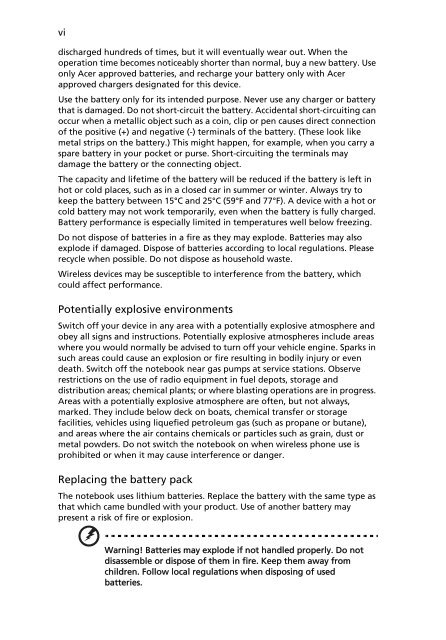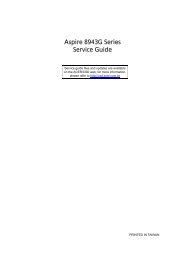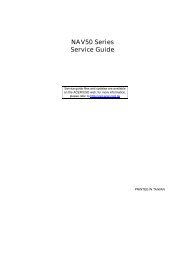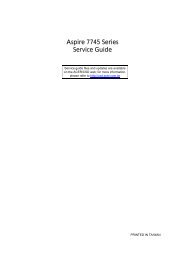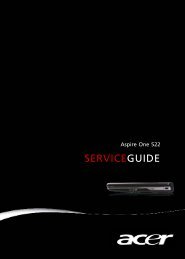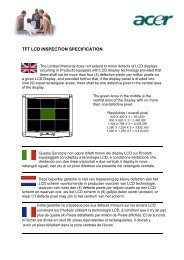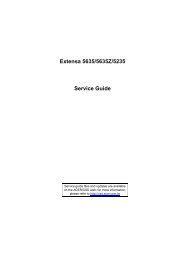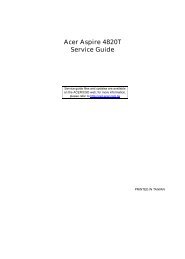Aspire 5310, 5710, 5710Z User's Guide EN - Acer Support
Aspire 5310, 5710, 5710Z User's Guide EN - Acer Support
Aspire 5310, 5710, 5710Z User's Guide EN - Acer Support
You also want an ePaper? Increase the reach of your titles
YUMPU automatically turns print PDFs into web optimized ePapers that Google loves.
vi<br />
discharged hundreds of times, but it will eventually wear out. When the<br />
operation time becomes noticeably shorter than normal, buy a new battery. Use<br />
only <strong>Acer</strong> approved batteries, and recharge your battery only with <strong>Acer</strong><br />
approved chargers designated for this device.<br />
Use the battery only for its intended purpose. Never use any charger or battery<br />
that is damaged. Do not short-circuit the battery. Accidental short-circuiting can<br />
occur when a metallic object such as a coin, clip or pen causes direct connection<br />
of the positive (+) and negative (-) terminals of the battery. (These look like<br />
metal strips on the battery.) This might happen, for example, when you carry a<br />
spare battery in your pocket or purse. Short-circuiting the terminals may<br />
damage the battery or the connecting object.<br />
The capacity and lifetime of the battery will be reduced if the battery is left in<br />
hot or cold places, such as in a closed car in summer or winter. Always try to<br />
keep the battery between 15°C and 25°C (59°F and 77°F). A device with a hot or<br />
cold battery may not work temporarily, even when the battery is fully charged.<br />
Battery performance is especially limited in temperatures well below freezing.<br />
Do not dispose of batteries in a fire as they may explode. Batteries may also<br />
explode if damaged. Dispose of batteries according to local regulations. Please<br />
recycle when possible. Do not dispose as household waste.<br />
Wireless devices may be susceptible to interference from the battery, which<br />
could affect performance.<br />
Potentially explosive environments<br />
Switch off your device in any area with a potentially explosive atmosphere and<br />
obey all signs and instructions. Potentially explosive atmospheres include areas<br />
where you would normally be advised to turn off your vehicle engine. Sparks in<br />
such areas could cause an explosion or fire resulting in bodily injury or even<br />
death. Switch off the notebook near gas pumps at service stations. Observe<br />
restrictions on the use of radio equipment in fuel depots, storage and<br />
distribution areas; chemical plants; or where blasting operations are in progress.<br />
Areas with a potentially explosive atmosphere are often, but not always,<br />
marked. They include below deck on boats, chemical transfer or storage<br />
facilities, vehicles using liquefied petroleum gas (such as propane or butane),<br />
and areas where the air contains chemicals or particles such as grain, dust or<br />
metal powders. Do not switch the notebook on when wireless phone use is<br />
prohibited or when it may cause interference or danger.<br />
Replacing the battery pack<br />
The notebook uses lithium batteries. Replace the battery with the same type as<br />
that which came bundled with your product. Use of another battery may<br />
present a risk of fire or explosion.<br />
Warning! Batteries may explode if not handled properly. Do not<br />
disassemble or dispose of them in fire. Keep them away from<br />
children. Follow local regulations when disposing of used<br />
batteries.


